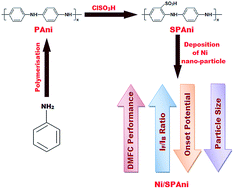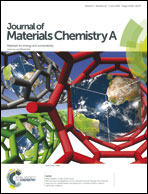Nickel nanocatalysts supported on sulfonated polyaniline: potential toward methanol oxidation and as anode materials for DMFCs
Abstract
The development of potential anode catalysts and catalyst supporting matrices for application in direct methanol fuel cells (DMFCs) has been an active area of research for the last couple of decades. The conventionally used Pt catalyst suffers from (a) high cost, (b) limited abundance and (c) the catalyst poisoning effect induced by the in situ generated carbon monoxide. In this work, a comparatively less expensive and more abundant Ni metal catalyst [supported on Vulcan carbon, polyaniline (PAni) and partially sulfonated PAni (SPAni)] has been utilized as a potential alternative to the Pt metal catalyst for the oxidation of methanol. SPAni emerged as the best matrix for the deposited Ni catalyst nanoparticles. This combination generated a peak current density of 306 μA cm−2 at +0.57 V. In addition, the Ni/SPAni catalyst produced a higher IF/IB ratio compared to the commercial Pt–Ru/C catalyst. Furthermore, a current density of 135 mA cm−2 (at +0.2 V potential) and a maximum power density of 27 mW cm−2 were obtained at 60 °C upon utilizing Ni/SPAni as the anode catalyst for DMFCs. The results, thus obtained, were better than those obtained for the commercial Pt–Ru/C, as well as, the Ni/C and Ni/PAni catalysts.


 Please wait while we load your content...
Please wait while we load your content...